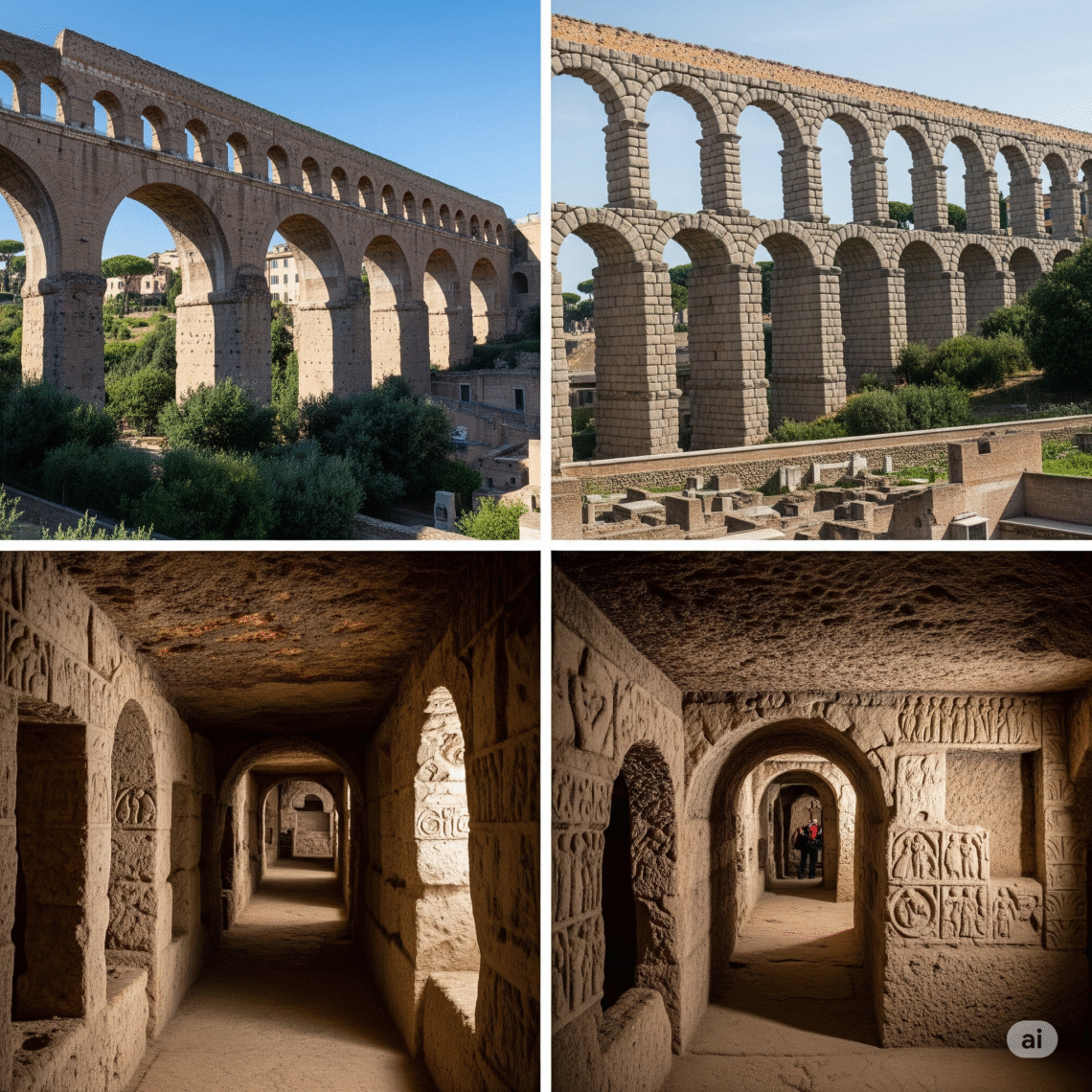Rome, known as the Eternal City, holds wonders beyond its well-trodden streets. While millions flock to marvel at the Colosseum or the Vatican, few venture beneath its surface or trace its ancient arteries above the ground. This guide is your passport to a lesser-known Rome, revealing the marvels of ancient aqueducts and mysterious catacombs that offer a truly unique glimpse into the city’s storied past. These sites unveil the ingenuity, artistry, and reverence of ancient Romans in ways no postcard could capture.
If you’re ready to step beyond the bustling piazzas and tourist queues, join us on this unforgettable journey through hidden Rome.
Ancient Roman Aqueducts
Marvels of Ancient Engineering
At the heart of Rome’s success was water—a resource the ancients mastered with remarkable precision. The Roman aqueducts stand as engineering marvels, delivering fresh water to homes, bathhouses, fountains, and more from as far as 60 miles away. Built as early as 312 BCE, aqueducts elevated the quality of life, making Rome the thriving metropolis of its time.
The ingenuity of these ancient structures lies in their ability to use gravity, stone arches, and underground channels to transport water seamlessly across vast terrains. Many remain standing today, a testimony to the craftsmanship and foresight of Roman engineers.
Must-Visit Aqueducts
- Aqua Appia
Rome’s oldest aqueduct, constructed in 312 BCE, was a pioneering achievement. Though much of it lies underground, portions are visible near the Via Appia. Aqua Appia brought water into Rome’s bustling center with little fanfare but enormous significance.
- Aqua Claudia
This towering aqueduct, constructed in 52 CE, is a sight to behold. Its massive stone arches snake across the countryside, offering insight into the scale of engineering the Romans achieved. Aqua Claudia is partially intact today near the Parco degli Acquedotti (Aqueduct Park), a serene retreat from the city’s chaos.
Exploring Ancient Aqueducts
Many aqueducts are accessible via guided tours or scenic hiking trails. If you’re visiting the Parco degli Acquedotti, take a leisurely walk through the park to admire ancient remnants set against rolling greenery. Pro tips for visiting:
- Wear comfortable walking shoes.
- Visit in the morning for fewer crowds.
- Bring a camera to capture the striking contrasts of nature and history.
The Mysterious Catacombs of Rome
A Glimpse into the Afterlife
Beneath Rome’s bustling streets lies an underground network steeped in reverence and mystery—the catacombs. These subterranean burial sites were constructed as early as the 2nd century CE, primarily by early Christians seeking a sacred and clandestine place to bury their dead during times of persecution.
The catacombs also serve as somber repositories of early Christian art and symbols, narrating stories of faith, persecution, and hope in times of adversity.
Notable Catacombs You Shouldn’t Miss
- Catacombs of Callixtus
Housing the burial sites of several popes and Christian martyrs, these catacombs are among Rome’s most significant. Admire the intricate frescoes and carvings that adorn the walls as guides narrate their history.
- Catacombs of Priscilla
Dubbed the “Queen of the Catacombs,” this site features striking frescoes, including one of the earliest depictions of the Virgin Mary. Prepare to be awed by its peaceful yet haunting atmosphere.
Practical Tips for Visiting
Whether you’re an art lover or a history buff, visiting the catacombs is an unmissable adventure. Here’s what you need to know before descending underground:
- Opening Hours: Most catacombs are open Tuesday through Sunday, but check specific timings in advance.
- Dress Code: Modest clothing is recommended, as these are sacred sites.
- Tours: Guided tours are highly recommended for learning about their religious and cultural significance.
Planning Your Visit to Hidden Rome

Best Time to Visit
For the best experience, avoid Rome’s scorching summers. Spring (April–June) and early fall (September–October) are ideal, offering pleasant temperatures and thinner crowds.
Getting Around
- Transportation: Many aqueducts and catacombs are reachable via public transport. For sites like Aqua Claudia, consider bike rentals or scenic walks.
- Accommodation: Staying in less tourist-heavy neighborhoods like San Giovanni can bring you closer to these hidden gems.
What to Pack
- A flashlight for dimly lit catacombs.
- Sturdy walking shoes for uneven terrain.
- Water and snacks for long tours.
Responsible Tourism
Respecting Historical Sites
Rome’s treasures are delicate; preserving them for generations to come is everyone’s duty. Always:
- Stick to marked paths.
- Refrain from touching ancient structures.
- Avoid loud conversations that disrupt the serenity of these sites.
Supporting Local Communities
Choose local guides, dine at family-owned trattorias, and shop at nearby markets to contribute directly to the community.
A Personal Journey into Hidden Rome
During my last trip to Rome, I embarked on an early morning hike through the Parco degli Acquedotti. Fog hung low, with the massive arches of Aqua Claudia gradually coming into view. It felt like stepping back thousands of years into Rome’s golden age. Later that week, I explored the Catacombs of Priscilla, humbled by the frescoes painted by hands from centuries past. These experiences offered a profound sense of connection not just to history but to humanity itself.
Why Hidden Sites Like These Matter
The aqueducts and catacombs remind us that the Romans were more than builders of empires; they were caretakers of life and death, engineers of endurance, and artists of the soul. Visiting these hidden sites connects us to a legacy that continues to shape the world today.
Start Your Own Roman Adventure
Rome’s aqueducts and catacombs invite you to explore a side of the city that most tourists miss. Beyond their history, they offer an unparalleled sensory experience that lingers long after your visit. Pack your curiosity and venture beyond the bustle to uncover Rome’s hidden heritage.
Not sure where to begin? Start planning your adventure today and share your own hidden discoveries with us in the comments below!
People Also Ask (PAA) Section
Q. What are Roman aqueducts?
A. Roman aqueducts are ancient structures that transported water across long distances to supply cities, towns, and public baths with fresh water.
Q. How many catacombs are there in Rome?
A. There are over sixty catacombs in and around Rome, though only a handful are open to the public.
Q. Do I need a guide to visit the catacombs?
A. While you can visit some catacombs independently, guided tours offer richer insights into their history and significance.
FAQs
How long does it take to visit the aqueducts and catacombs?
A typical visit to the aqueduct park or catacombs lasts 2–3 hours. With travel included, plan for half a day for each site.
Are aqueducts and catacombs suitable for kids?
Yes, but keep in mind that the catacombs may be dark and slightly eerie, which might not be ideal for very young children.
Do I need to book tickets in advance?
It’s recommended for popular sites like the Catacombs of Callixtus, especially during peak tourism seasons.





